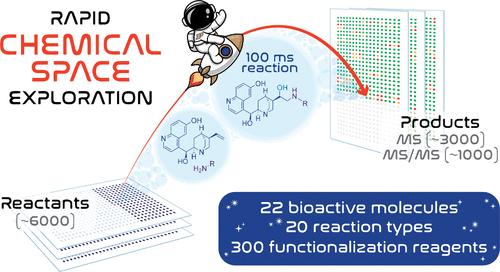当前位置:
X-MOL 学术
›
J. Am. Chem. Soc.
›
论文详情
Our official English website, www.x-mol.net, welcomes your
feedback! (Note: you will need to create a separate account there.)
Rapid Exploration of Chemical Space by High-Throughput Desorption Electrospray Ionization Mass Spectrometry
Journal of the American Chemical Society ( IF 14.4 ) Pub Date : 2024-11-19 , DOI: 10.1021/jacs.4c11037 Kai-Hung Huang, Nicolás M. Morato, Yunfei Feng, Alexis Toney, R. Graham Cooks
Journal of the American Chemical Society ( IF 14.4 ) Pub Date : 2024-11-19 , DOI: 10.1021/jacs.4c11037 Kai-Hung Huang, Nicolás M. Morato, Yunfei Feng, Alexis Toney, R. Graham Cooks

|
This study leverages accelerated reactions at the solution/air interface of microdroplets generated by desorption electrospray ionization (DESI) to explore the chemical space. DESI is utilized to synthesize drug analogs at an overall rate of 1 reaction mixture per second, working on the low-nanogram scale. Transformations of multiple drug molecules at specific functionalities (phenol, hydroxyl, amino, carbonyl, phenyl, thiophenyl, and alkenyl) are achieved using electrophilic/nucleophilic, redox, C–H functionalization, and coupling reactions. These transformations occur under ambient conditions on the millisecond time scale with direct detection of products being successful in all but three of the reaction types studied. The large scope (22 bioactive compounds, >20 chemical transformations, and >300 functionalization reagents) and high speed (>3000 reactions/hour) provide access to a wide array of drug analogs that can be used for bioactivity testing. A total of ∼6800 unique reactions were examined through a data-driven workflow, and more than 3000 unique derivatives (∼44%) were identified tentatively by the m/z value and signal-to-control ratio in single-stage mass spectrometry (MS) analysis, with over 1000 being further characterized by tandem MS. The speed of the DESI-MS reaction screen provides potential advantages for emerging machine learning-based predictions of organic synthesis, and it sets the stage for future online DESI-MS bioassays and scaled-up microdroplet synthesis before formal characterization of hit compounds is sought using traditional methods of drug discovery.
中文翻译:

通过高通量解吸电喷雾电离质谱法快速探索化学空间
本研究利用解吸电喷雾电离 (DESI) 产生的微滴在溶液/空气界面处的加速反应来探索化学空间。DESI 用于以每秒 1 种反应混合物的总速率合成药物类似物,在低纳克尺度上工作。使用亲电/亲核、氧化还原、C-H 官能团化和偶联反应实现具有特定官能团(苯酚、羟基、氨基、羰基、苯基、噻苯和烯基)的多种药物分子的转化。这些转化发生在环境条件下的毫秒级时间尺度上,除三种反应类型外,所有反应类型均成功直接检测产物。大范围(22 种生物活性化合物、>20 化学转化和 >300 官能化试剂)和高速(>3000 次反应/小时)提供了可用于生物活性测试的各种药物类似物。通过数据驱动的工作流程共检查了 6800 多个独特反应,在单级质谱 (MS) 分析中,通过 m/z 值和信噪比初步鉴定了 3000 多个独特衍生物 (∼44%),其中 1000 多个通过串联 MS 进一步表征。DESI-MS 反应筛选的速度为新兴的基于机器学习的有机合成预测提供了潜在优势,并为未来的在线 DESI-MS 生物测定和放大微滴合成奠定了基础,然后才能使用传统的药物发现方法寻求苗头化合物的正式表征。
更新日期:2024-11-20
中文翻译:

通过高通量解吸电喷雾电离质谱法快速探索化学空间
本研究利用解吸电喷雾电离 (DESI) 产生的微滴在溶液/空气界面处的加速反应来探索化学空间。DESI 用于以每秒 1 种反应混合物的总速率合成药物类似物,在低纳克尺度上工作。使用亲电/亲核、氧化还原、C-H 官能团化和偶联反应实现具有特定官能团(苯酚、羟基、氨基、羰基、苯基、噻苯和烯基)的多种药物分子的转化。这些转化发生在环境条件下的毫秒级时间尺度上,除三种反应类型外,所有反应类型均成功直接检测产物。大范围(22 种生物活性化合物、>20 化学转化和 >300 官能化试剂)和高速(>3000 次反应/小时)提供了可用于生物活性测试的各种药物类似物。通过数据驱动的工作流程共检查了 6800 多个独特反应,在单级质谱 (MS) 分析中,通过 m/z 值和信噪比初步鉴定了 3000 多个独特衍生物 (∼44%),其中 1000 多个通过串联 MS 进一步表征。DESI-MS 反应筛选的速度为新兴的基于机器学习的有机合成预测提供了潜在优势,并为未来的在线 DESI-MS 生物测定和放大微滴合成奠定了基础,然后才能使用传统的药物发现方法寻求苗头化合物的正式表征。


















































 京公网安备 11010802027423号
京公网安备 11010802027423号